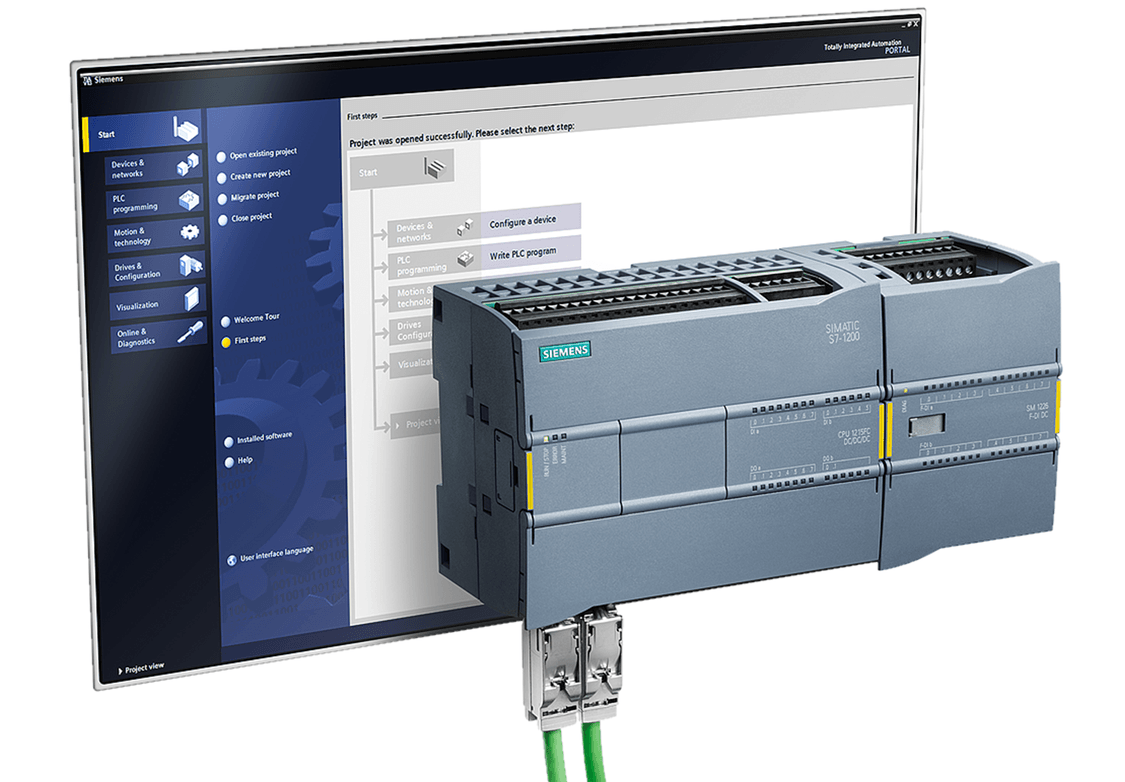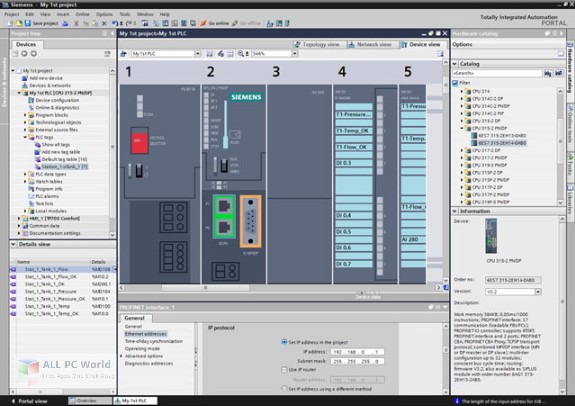
- #SIMATIC STEP 7 EXAMPLES UPDATE#
- #SIMATIC STEP 7 EXAMPLES SOFTWARE#
- #SIMATIC STEP 7 EXAMPLES SERIES#
I0.2 status bit is a logic 1 because the normally closed (NC) overload relay (OL) contacts are closed. Initially, I0.1 status bit is a logic 1 because the normally closed (NC) Stop push-button is closed. These inputs are used to control normally open contacts in a line of ladder logic programmed into the PLC. In the following example, a normally open Start push-button is wired to the first input (I0.0), a normally closed Stop push-button is wired to the second input (I0.1), and a normally closed overload relay contacts (part of the motor starter) are connected to the third input (I0.2). The motor control application can also be accomplished with a PLC.
#SIMATIC STEP 7 EXAMPLES SERIES#
A motor starter coil (M) is wired in series with a normally open, momentary Start push-button, a normally closed, momentary Stop push-button, and normally closed overload relay (OL) contacts. This example will show the practical aspect of programming in Step 7 with a real, existing part of a system. This editor doesn’t use the term “power flow”, as in the LAD, it expresses a similar concept of the control flow through the FBD logic blocks. There are no contacts, but there are equivalent functional units. This editor displays the program in the form of conventional logic circuits. 4 Example of logical script in STLįunction Block Diagram (FBD) – functional block diagram. Programming in STL is very similar to the assembler language, but it’s more specific. In this editor you can create programs that can not be created in the LAD and FBD editor. This editor allows you to create a program by entering the mnemonic commands. Statement List (STL) – list of instructions. Ladder logic incorporates programming functions that are graphically displayed to resemble the symbols used in hard-wired control diagrams. Ladder logic (LAD) is one programming language used with PLCs. PLC programming can be done also with the help of Simatic Manager, which provides the possibility to write programs in three programming languages:

#SIMATIC STEP 7 EXAMPLES SOFTWARE#
SIMATIC software with STEP 7 and numerous engineering tools supports all phases of product deployment, from hardware configuration of the system and parameterization of modules to service of the installed system. SIMATIC software is the universal configuring and programming environment for SIMATIC controllers, human machine interface systems and process control systems. A change in function or system expansion required extensive component changes and rewiring. If an error was made, the wires had to be reconnected correctly. Electricians would then wire the necessary components to perform a specific task. This is often referred to as hard-wired control.Ĭircuit diagrams had to be designed, electrical components specified and installed, and wiring lists created. Prior to PLCs, many control tasks were performed by contactors, control relays and other electromechanical devices. In addition to these basic elements, a PLC system may also incorporate an operator interface device of some sort to simplify monitoring of the machine or process. Once entered, the program and associated variables are stored in the CPU.

The programming device is used to enter and change the PLC’s program, to monitor and change the stored values. The output modules convert the control signals from the CPU into digital or analog values that can be used to control various output devices.
#SIMATIC STEP 7 EXAMPLES UPDATE#
The CPU then sends signals to update the status of the outputs. The CPU evaluates the statuses of the inputs, outputs, and other variables as it executes a stored program. The primary function of a PLC’s input circuitry is to convert the signals provided by these various switches and sensors into logic signals that can be used by the CPU.

These analog signals represent machine or process conditions as a range of voltage or current values. Other modules or inputs respond to analog signals. Some input modules or points respond to digital inputs, also called discrete inputs, which are either on or off.

The type of the input modules or points used by a PLC depends upon the types of the input devices used. The basic elements of a PLC include input modules or points, a central processing unit (CPU), output modules or points, and a programming device. While the specific applications vary widely, all PLCs monitor inputs and other variable values, make decisions based on a stored program, and control outputs to automate a process or machine. PLCs differ from office computers in the types of tasks that they perform, and the hardware and software they require to perform these tasks. A programmable logic controller (PLC), also referred to as a programmable controller, is the name given to a type of computer commonly used in commercial and industrial control applications.


 0 kommentar(er)
0 kommentar(er)
